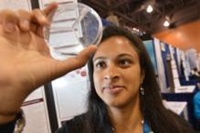Californian teen’s invention charges mobiles in 30 seconds
21 May 2013
A tiny device capable of recharging cell phone batteries in just 30 seconds has won 18-year-old Eesha Khare a major science award that would fund her college education at Harvard University.
 Khare's invention won her a Young Scientist Awards in the Intel International Science and Engineering Fair.
Khare's invention won her a Young Scientist Awards in the Intel International Science and Engineering Fair.
Khare a senior at Lynbrook High School in Saratoga, California who travelled to Phoenix last week to receive her award told CNN affiliate KPIX 5 that she was in a daze and could not believe this had happened.
She said, the device, a black, rectangular type of supercapacitor just over an inch long, could charge a cell phone battery in 20 to 30 seconds.
She said, she developed a new supercapacitor, which was basically an energy storage device which could hold a lot of energy in a small amount of volume. She said, the technology might also be able to speed up charging of automobile batteries.
The award included a $50,000 prize that would come in handy when Khare headed to Harvard in the fall, she told KPIX 5. With a laugh, she predicted that she would be setting the world on fire.
The other prize for the same amount went to Henry Lin of Shreveport, Louisiana, for simulating thousands of clusters of galaxies" to allow scientists to "better understand the mysteries of astrophysics: dark matter, dark energy and the balance of heating and cooling in the universe's most massive objects," the Intel statement said.
"The best part of my project was seeing its practical application. After charging my super capacitor for 20 seconds, I was able to light a LED device and that's an amazing accomplishment," said Khare at an engineering fair.
The device can last for 10,000 charge-recharge cycles, as against only 1,000 cycles for conventional rechargeable batteries.
It was Khare's interest in nano-chemistry that led to the invention.
She said after receiving the prize money, she would be able to pay for her college and also work on making scientific advancements. Her invention could also have applications in car batteries.
The nano-tech device is flexible enough to be used in clothing or displays on any non-flat surface.
The science fair saw over 1,600 finalists from around the world compete for the top prize of $75,000 awarded by Intel, runners up received $50,000 scholarships.
The top prize went to Ionut Budisteanu, a 19-year-old student from Romania, took the first place prize for creating a self-driving car using artificial intelligence.













.jpg)






.jpg)









